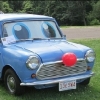There's very few common micrometers that you'll be able to use to measure the thickness of the register in the hub with. There's a technique I've been using mostly on the front hubs, but also works on the rear hubs. You can see it in this post;-
https://www.theminif...wheel-bearings/
Just be sure there's no burs or dings on the hub face that you are measuring to. Also, while it might at first glance appear unnecessary to fit the second bearing cup and them measure to that, instead measuring directly to the register, I would suggest is fraught with inaccuracy as the registers can have a small taper on them, so by fitting the cup, you are actually measuring to the cup's fitted position.
While in that post I show doing this with verniers, I actually do them with a depth micrometer. If you don't have a depth micrometer, then decent verniers that will do repeatable measurements are better than nothing.
That's because it wasn't a big issue until recently when new old stock Rover hubs hit the market place which are more prone to having the issue.
Is there a way we can identify the Rover Hubs ? A friend bought a new hub about a year back, one thing I noticed was it only had a single screw hole for the brake drum. Was that a Rover Hub or some after market replacement ?
















